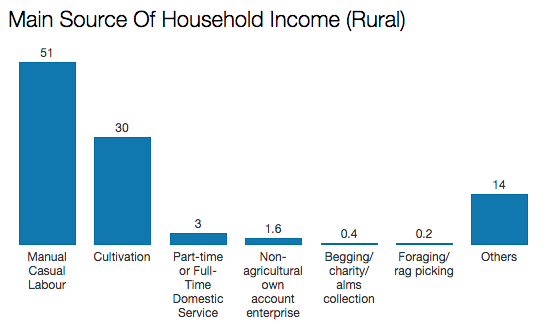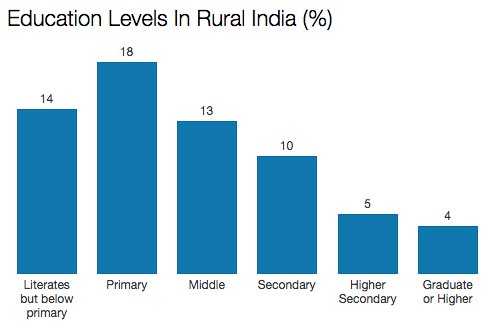* 51% of households make a living from manual labour
* 28% (over 50 million) of households do not have mobile phones or any form of communication
More than 70 million rural households face some form of exclusion, either from assets or socio-economic benefits, according to data released by the Socio-Economic Caste Census survey last week. As many as 833 million Indians, or 69% of the population, live in rural areas.
The SECC report comes at a time when global credit rating agencies, such as Moody’s, have warned that slow growth in rural India may cripple the overall economy. Rating agencies have laid stress on speeding rural reforms. IndiaSpend has previously discussed reforming agriculture and rural administration.
Rural Poor and Sources of Income
More than half of rural households depend on manual labour for livelihood, and 75% of the rural population, or 133.5 million families, earn less than Rs 5,000 per month.

Source: Social Economic and Caste Census, 2011
“A preliminary analysis reveals a grim picture of rural areas with three in four rural households earning less than Rs 5,000 per month and almost 90% of households having incomes of less than Rs 10,000 per month,” Himanshu (he uses only one name), an agricultural economist with Delhi’s Jawaharlal Nehru University wrote in Mint, citing the findings of the Arjun Sengupta committee, 2007, which identified 77% of India’s population as poor.
“Overlooked by the media, these numbers are very close to the estimates of poor and vulnerable derived from other estimates based on the consumption surveys of the National Sample Survey Office. Rs 5,000 per month per household with an average household size of five would also mean an income of Rs 33 per person per day in the rural areas,” wrote Himanshu.
Although it is not meant to be a comparison of poverty estimates, the SECC data reveals that about 670 million Indians in rural areas alone live on Rs 33 per day (75% of rural households is around 134,373,569 households; five members per household gives us a total of 671,867,845 people).

Source: Social Economic and Caste Census, 2011
Poor housing quality
A little less than half of the houses in rural India are kuccha (not solid).


Source: Social Economic and Caste Census, 2011
Having a pucca (permanent) house is an indicator of a higher standard of living.

Source: Social Economic and Caste Census, 2011
Poverty and a low standard of living are reflected in asset ownership. While 71% of village households have mobile phones, refrigerators and motor vehicles are not very common in rural households.
Education Levels
IndiaSpend recently reported how rural India has more illiterate people than the population of Indonesia. With 74% of families living on less than Rs 5,000 a month, this will not change immediately, which in turn will keep economic standards depressed, as we have explained in a previous report.

Source: Socio Economic and Caste Census, 2011
Projects such as Mahatma Gandhi National Rural Employment Guarantee Act (MGNREGA), National Rural Livelihoods Mission (NRLM), Pradhan Mantri Gram Sadak Yojna and Swachh Bharat Mission are the major schemes for rural development in India.
Rural India continues to be trapped in a vicious circle of poverty. A clue to the first step to break out of that cycle comes from what is called the graduation model, a global experiment that could become an anti-poverty guide for Prime Minister Narendra Modi.
This article was originally published on IndiaSpend.com, a data-driven and public-interest journalism non-profit.










